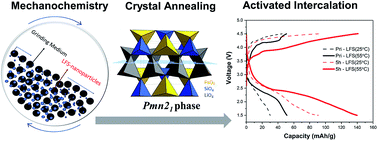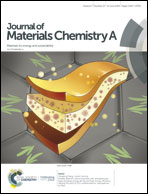Mechanochemically tuned structural annealing: a new pathway to enhancing Li-ion intercalation activity in nanosized βII Li2FeSiO4†
Abstract
In this work, a relatively inactive cathode material, βII orthorhombic Li2FeSiO4 with the Pmn21 space group, is shown to undergo crystal structural changes when subjected to nanosizing by high-energy milling that have a pronounced activation impact on Li-ion intercalation electrochemistry. In particular, we present evidence of mechanically induced structural annealing including lattice expansion, reduction of anti-site defects and preferred crystal orientation, opposite of what expected typically from nanosizing. As a result of this type of unreported structural activation for orthosilicates, a threefold increase of the accessible discharge (=intercalation) capacity of the high-energy milled Pmn21 material is attained, much higher than what would be expected solely from surface area increase due to nanosizing and surface area increase. Such mechanochemically induced structural annealing activates Li-ion diffusion (one order of magnitude enhancement in DLi) into less accessible sites via the combined effects of anti-site defect removal and modulation of the Fe–O coordination adjustment. Structural activation of intercalation materials via controlled mechanochemistry opens new possibilities in nanoengineering high energy density Li-ion storage electrodes.



 Please wait while we load your content...
Please wait while we load your content...